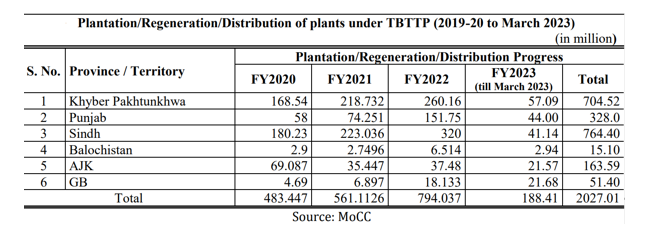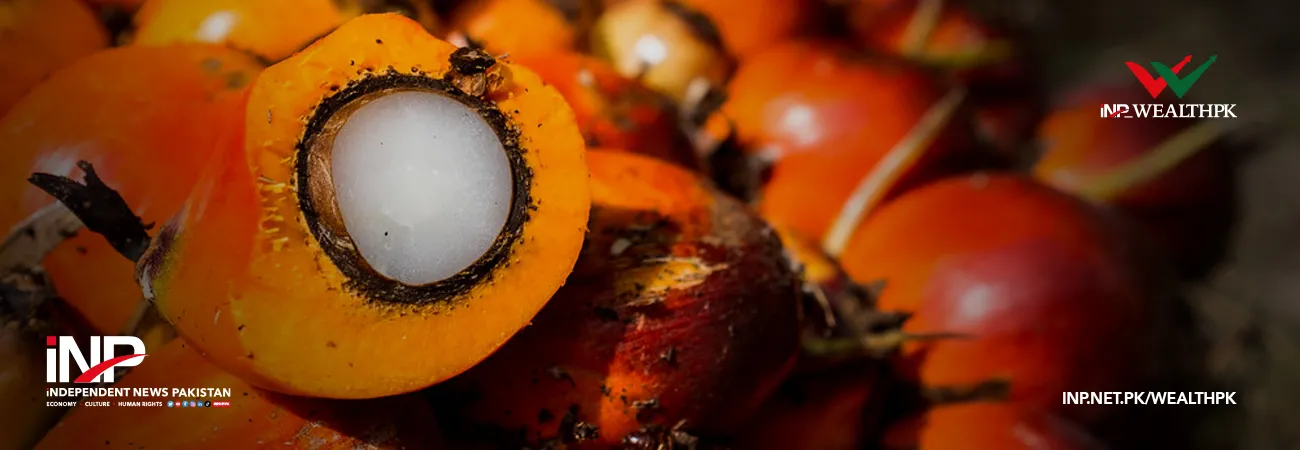INP-WealthPk
Arsalan Ali
In 2023, Pakistan’s massive tree plantation campaign, Ten Billion Tree Tsunami Programme (TBTTP), continues its mission to promote afforestation and regeneration across provinces and territories, and address the challenges of climate change. This project strives to restore and preserve natural ecosystems, enhance biodiversity, and mitigate the adverse effect of greenhouse gas emissions, said the Ministry of Climate Change and Environmental Coordination. According to a document available with WealthPK, as of March 2023, significant progress has been made in the implementation of the TBTTP.
The allocated funds, totalling Rs3.296 billion from both the Public Sector Development Programme (PSDP) and Annual Development Programme (ADP), have been effectively utilised. This financial support has played a crucial role in driving the success of the initiative. From July 2022 to March 2023, a remarkable achievement was made, with 188.41 million plants successfully planted, regenerated, or distributed. This accomplishment has further contributed to the cumulative total of 2.027 billion plants planted, regenerated, or distributed since the inception of the programme.

The TBTTP and mangrove forest restoration projects have not only contributed to Pakistan’s efforts to reduce carbon emissions but also opened up a potential revenue stream through the trading of carbon credits on the international voluntary carbon market. The implementation of TBTTP – upscaling of the Green Pakistan Programme – was initiated in 2019 and would last four years (2019-2023) to plant or regenerate 3.29 billion saplings, with a total cost of Rs 125.1843 billion. The ministry’s document states that a cumulative total of 2.027 billion saplings were planted, and the trees planted or regenerated under the project have the potential to sequester 148 million tonnes of carbon equivalent over 10 years, if implemented fully.
One of the highlights of Pakistan’s green initiative is the restoration of the country’s mangrove forests. The current area of Indus Delta are estimated at 667,000 hectares, out of which 240,000 hectares are inhabited by mangroves. The ministry’s document says Pakistan is the only country in the region where mangrove cover is increasing, with an overall 300% increase since 1990, mainly in the Indus Delta. The Indus Blue Carbon (IDBC) project initiated by the Sindh Forest Department aims to restore 350,000 hectares of mangroves over 60 years in the coastal districts of Thatta and Sujawal through a multi-phase public-private partnership.
It states that Phase-1 aims for the restoration of 224,997 hectares of degraded land through large-scale reforestation, of which 75,000 hectares were restored by 2020 with mangrove plantations, with an investment of $50 million from partners. Pakistan has also completed the essential requirements for REDD+ (Reducing Emissions from Deforestation and Forest Degradation) implementation under the United Nations Framework Convention on Climate Change (UNFCCC). The REDD+ concept enables countries to access result-based payments against measured, reported, and verified emissions reduction and removals. Through the TBTTP and initiatives like IDBC and REDD+, Pakistan is making significant strides in the fight against climate change.
Pakistan is not only reducing its carbon emissions but also paving the way for sustainable development and creating potential revenue streams through carbon credit trading. According to a recent report by the United Nations Development Programme (UNDP), Pakistan is particularly vulnerable to these climate change impacts. Pakistan is facing an imminent threat of increased variability in monsoons, receding Himalayan glaciers, and extreme weather events like floods and droughts, which could potentially cause food and water insecurity. However, the Pakistan government is taking swift action to address this pressing issue.
In addition to the existing TBTTP, the government has pledged to increase the country’s protected areas to 15% by the end of 2023. In 2018, the protected areas stood at 12%. This commitment by the government highlights its dedication to combatting climate change and its negative consequences on the environment and people of Pakistan.
Credit : Independent News Pakistan-WealthPk













